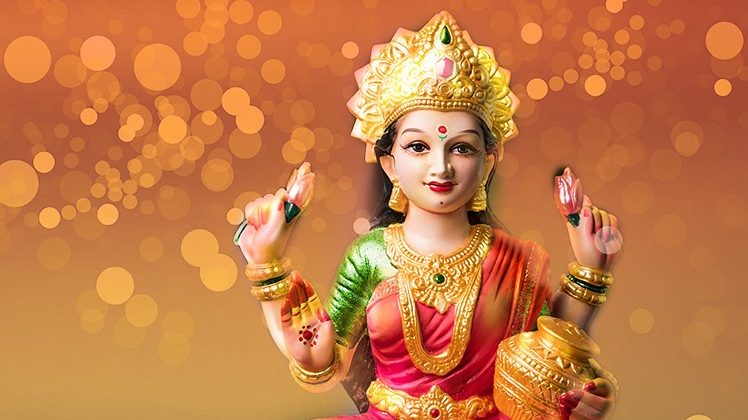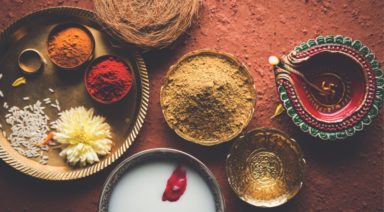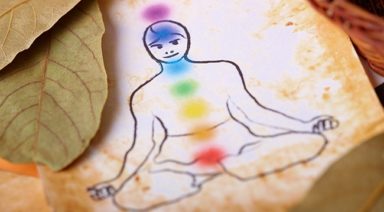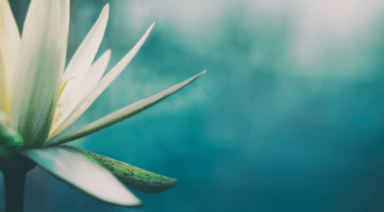The Power of Lakshmi: Confronting Negativity in Your Life

My first encounter with the goddess Lakshmi was, as a child, watching my mother dress in her finest silks and taffeta dresses for parties and going to the symphony, as well as her financial contribution to the arts and education. While my mother modeled Lakshmi, at sixteen I dressed in oversized khakis and my father’s flannel shirts. I wore just about anything that would cover up my piston thighs and my discomfort as my body was changing.
While I was an avid athlete and modern dancer, it wasn’t until I started formal yoga practice in my twenties that I began to confront my negative body image and to have reverence for myself. Each inhale asked me to fill up with gratitude for breath, for life, for this body. Every exhale invited me to let go of my negative self-talk.
Each posture evokes positive attributes such as the strength and elegance of a mountain, the uprightness of a regal tree, and the wisdom of a sage. Through yoga practices, we begin to recalibrate our inner map and rewrite the story we wish to live, one of vibrant creativity, joy, and reverence for life. As one of my teachers Douglas Brooks teaches, “Turn your Klesha’s (pain) into Lakshmis ( jewels).” Take your negativity and pain and get creative with life. Make more beauty out of our pain.
It’s said that anytime Lakshmi is disrespected she leaves her human form and takes refuge and protection in nature. The way in which humans disconnect from the life force in themselves and consequently in everything else has caused us to be in a deep, heavy sleep and living in denial.
Environmental devastation, indecent treatment of animals, and catastrophe will persist until humans wake up to the feminine essence in themselves and in everything. This is what the word yoga insists upon, the integration of the masculine and feminine within every human being. We need the masculine to hold a boundary, to help us act in the world, but without the feminine, we lack the ability to reflect upon our actions and speech, and the ability to nurture and sustain. Without the feminine human beings very well could perish.
Get to Know the Goddess

Source: www.maadurgawallpaper.com
This Hindu goddess name is derived from the verbal root Lak, which means to mark, signify, or characterize. She is a mark of beauty—auspicious and abundantly full. She is the Goddess that shines, shimmers, and is refined from the inside out.
Lakshmi’s mythic character is often seen rising up from the ocean glamorously adorned in a silk sari, gold earrings dangling from her ears, and a dazzling necklace. Often elephants surround her, bathing her in water, which is a sign of prosperity. Any time we find ourselves near water—waterfalls, at the ocean, near lakes, and streams— we are in Lakshmi’s abundant flow.
On the flip side, global warming and droughts that plague our planet represent the shadow aspect of Lakshmi. Our inability to see that we are inextricably connected to each other and nature is the shadow side of Lakshmi, we call her, Alakshmi ( inauspicious). She begs us to look at the sustainability of our resources and to become creative in our capacities to preserve her essence in the form of all-natural resources.
Lakshmi holds a generous amount of gold coins that flow out from her left hand. Her inner radiance transmutes into material prosperity, which hints to how she is successful in her material, physical life. To prosper in life, Lakshmi’s myth suggests that we first must honor all that life is providing for us, it can be easy to fall into a sense of lack and focus on all that is not going well, but Lakshmi’s myth suggests that we must wake up to the ocean of abundance in our lives.
Any time we lose sight of the feminine, the more reflective part of us must wake up to the possibility of recreating ourselves over and over again. Lakshmi shows us that we must utilize pain, disappointment, and shadow to make the shift. In fact, the Tantric philosophy of yoga suggests it’s necessary that we confront and move through our resistance and shadow sides in order to make beauty. It’s like the beautiful lotus flower that shines so brightly on the surface of a murky, dark pond. The mud in which its roots grow is necessary for it to blossom.
Lakshmi’s left-hand gestures Abhayamudra, a mudra that suggests we all must confront our limiting beliefs, fear, and doubt and stand strong in our courage. We must face our demons, and evolve, growing and transforming our pain and struggles, and turning them into our assets. This is what yoga asks of us.
The Myth of Lakshmi
To understand Lakshmi, it helps to know the myth in which she plays a key role.
Once upon a time, there was a grumpy old sage named Durvasas, whom everyone disliked due to his negative attitude. That is, until the day Lakshmi offered him a garland of flowers as he emerged from meditation. The flowers instantly brought Durvasas into a state of inner radiance and gratitude, and he wanted to share the flowers—and what they represented—with Indra, the king of the Gods.
Indra, however, wasn’t so excited to receive this gracious gift. At this moment, every flower on the garland began to wilt. And not just the flowers, but all of the food in the area began to spoil and the air became toxic. After all, the feminine had been disrespected.
When this happened, Lakshmi disappeared into thousands of particles of light deep into the ocean, where she remained until the Gods and demons recreated her by churning in the milky ocean of light and dark, joy, and pain.
Lakshmi’s descent into the ocean is the process of meditation practice. We dive deep into the oceanic inner world where we vibrate and pulsate like an ocean wave. All we have to do is simply close our eyes, listen closely to the heart’s beat, notice our eyes blinking and register blood moving through our veins to get in touch with this inner space.
Like Lakshmi’s oceanic journey, meditation takes us deep into the inner core where our shadow will be revealed; this is where negative memories and limiting beliefs are stored. Of course, our beauty and joy are also registered here. It is in this churning that Lakshmi rises to the surface again in all her beauty and fullness.
It is also true for each of us as we come out of meditation, we may find that at first we are exhausted, irritable, or might feel like crying. These are ways we begin to release old inhibiting patterns. Eventually, over time, and with regular practice, we come out feeling lighter, more joyous, and free to access our gifts, talents, and creativity.
Your Daily Lakshmi Practices
In addition to applying Lakshmi’s lessons when practicing yoga and meditation, there are a number of ways to embody this beautiful Hindu goddess in your everyday life—and many of these tips don’t take much time or money. To ignite your inner spark and step into the fullness of your beautiful grace, try one of these practices this week:
- Buy fresh flowers for your home
- Take a walk in nature with gratitude for its beauty and fresh air
- Take a shower or bath and offer a moment of gratitude for the water flowing over your body
- Serve dinner on your “fancy” dishwater, set a beautiful table, and light a few candles—make it feel like a holiday meal even on a random Wednesday
- Wear your most exquisite yoga tights and mala to yoga class
- Practice Lotus Pose, Padmasana, or hip openers like Eka Pada Rajakapotasana
- Donate to the humane society or any cause of your choice
- Clean your house, tidy your desk space at work, or vacuum your car
- Dress with intention: Wear your most beautiful shirt, dress, scarf, and jewelry
- Keep a gratitude journal
Lalitha Invites Beauty and Play Through Sugarcane Pose

I’m sure at some point in your yoga journey you have unknowingly experienced Sugarcane Pose. Sugarcane pose’s English translation is rarely used. Instead, it is referred to as Ardha Chandra Chapasana, or just Chapasana. It is a standing backbend version of Half Moon Pose (Ardha Chandrasana). Ardha means ‘half,’ Chandra means ‘moon,’ Chap means ‘bow,’ and Asana means ‘pose’.
I’m half Filipina and I was lucky to have a father working for the U.S. government who was interested in working in Southeast Asia because he is Filipino, so I lived there until the age of 17. Whether we were in Taipei, Seoul, Manila or Jakarta, there would always be a street stand selling raw sugarcane.
As a result, I grew up gnawing on sugarcane husks, relishing in the flavor of the sugary sweet juice and the texture of the dense, fibrous cane. When I heard the name sugarcane pose and discovered that Lalitha was sometimes referred to as the Sugarcane Goddess, I felt very connected to both the pose and the goddess and wanted to know more.
Lalitha’s Depiction
One translation of Lalitha’s name is ‘she who plays.’ When we invite the essence of Lalitha into our lives, we are inviting spontaneity, playfulness, and joy into our lives. She is a form of Shakti Devi, the auspicious feminine energy relevant to the Universe or Source. She represents beauty, and her depiction conveys that.
Lalitha is usually seen seated on a lotus flower which guides us toward fulfilling our desires. She has long, black, gorgeous hair that smells like flowers, and a slight red tinge to her skin tone.
Her skin color is beautiful and represents the color of the first dawn or the hopefulness of new beginnings, and she is sometimes referred to as the Red Flower Goddess. She has four arms and a crescent moon adorns her forehead. In her hands, she holds a bow of sugarcane, five arrows made of flowers, a farming instrument for rounding up cattle (a goad), and a noose. The goad and noose represent our ability to develop an aversion (goad) to attachment (noose) and eventually find true joy.





































